
Consider the circuit shown in Figure P2.47. Assume each diode cut−in voltage is
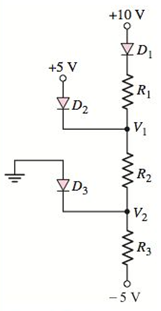
Figure P2.47
(a)
The values of
Answer to Problem 2.47P
The required values are,
Explanation of Solution
Given:
Diode’s cut-in voltage =
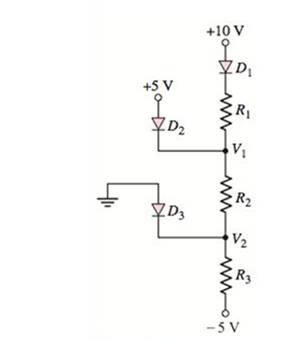
Calculation:
Assume all diode are conducting.
Draw the circuit diagram with node voltages and cut-in voltages.
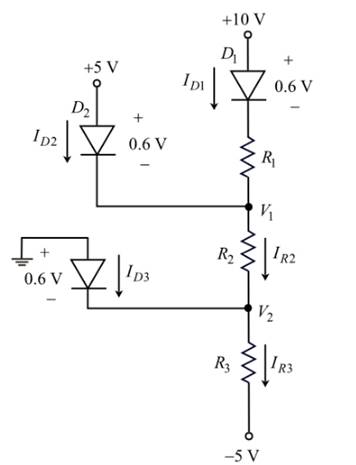
Figure 1
From Figure 1, the voltage at node
The voltage at node
Write the expression for current following through diode
Substitute
Therefore, the value of the resistor,
Apply Kirchhoff’s current law at node
Substitute
Calculate the value of resistor
Substitute
Therefore, the value of the resistor
Apply Kirchhoff’s current law at node
Substitute
Calculate the value of resistor
Substitute
Therefore, the value of the resistor,
Conclusion:
Therefore, the required values are
(b)
To find: The values of
Answer to Problem 2.47P
The required values are,
Explanation of Solution
Given:
Diode’s cut-in volt- age is
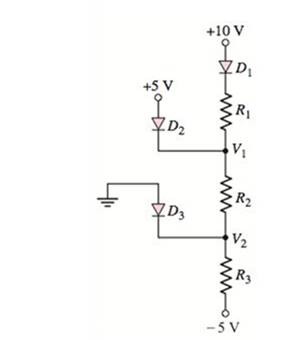
Calculation:
Assume at diodes are conducting.
From Figure 1, the voltage at node
The voltage at node
Calculate the current,
Substitute
Therefore, the current following through diode
Calculate the current following through resistor
Substitute
Apply Kirchhoff’s current law at node
Substitute
Therefore, the current following diode
Calculate the current following through resistor,
Substitute
Apply Kirchhoff’s current law at node
Substitute
Therefore, the current following diode
Conclusion:
Therefore, the required values are
(c)
To find: The values of
Answer to Problem 2.47P
The require values are
Explanation of Solution
Given:
Diode’s cut-in volt- age is
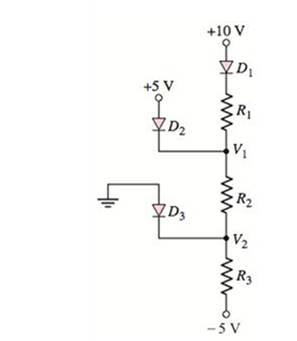
Calculation:
Assume diode
Draw the current diagram with node voltage and cut-in voltages.
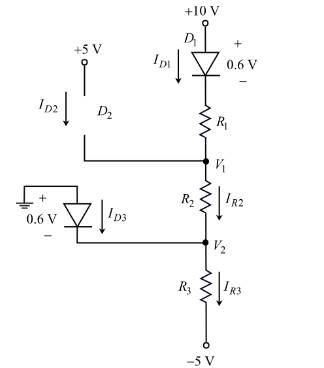
Figure 2
In Figure 2, the Diode
That is,
Therefore, the current following through diode
From Figure 2, the voltage at node
Apply Kirchhoff’s current law at node
Substitute
Calculate the current
Substitute
Therefore, the current following diode
From Figure 2,
Calculate the current following through resistor,
Substitute
Apply Kirchhoff’s current law at node
Substitute
Therefore, the current following diode
(d)
To find: The values of
Answer to Problem 2.47P
The required values are
Explanation of Solution
Given:
Diode’s cut-in volt- age is
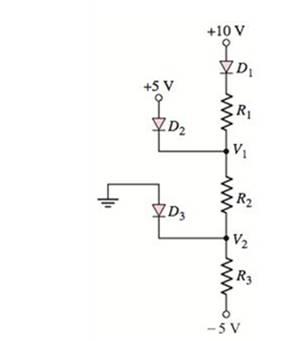
Calculation:
Assume diode
Draw the circuit diagram with node voltages and cut-in voltages.
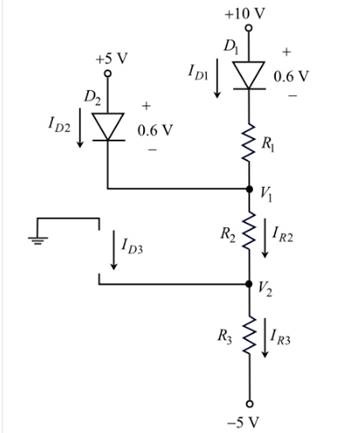
Figure 3
In Figure 3, the Diode
That is,
Therefore, the current following through diode
From Figure 1, the voltage at node
Therefore, the node voltage,
Apply Kirchhoff’s current law at node
Substitute
Calculate the current
Substitute
Therefore, the current following diode
Calculate the current following through resistor,
Substitute
Apply Kirchhoff’s current law at node
Substitute
Want to see more full solutions like this?
Chapter 2 Solutions
MICROELECT. CIRCUIT ANALYSIS&DESIGN (LL)
- A communication satellite is in stationary (synchronous) orbit about the earch (assume altitude of 22.300 statute miles). Its transmitter generates 8.0 W. Assume the transmit- ting antenna is isotropic. Its signal is received by the 210-ft diameter tracking parabo- loidal antenna on the earth at the NASA tracking station at Goldstone, California. Also assume no resistive loss in either antenna, perfect polarization match, and perfect impedance match at both antennas. At a frequency of 2 GHz. determine the: (a) power density (in watts/m²) incident on the receiving antenna. (b) power received by the ground-based antenna whose gain is 60 dB.arrow_forwardDon't use ai to answer I will report you answerarrow_forwardA plane wave traveling in z-direction through a medium with &=8, μ-2 and has the electric and magnetic field intensity at z=0 shown in Fig. 6.1 and Fig. 6.2, respectively. Utilize the provided information to find the following: (a) w (b) The intrinsic impedance of the medium © B (d) a (e) The expression of the magnetic field intensity, H (f) The time-average power carried by the wave Magnetic Field Intensity (mA/m) Electric Field Intensity (V/m) 0.5 0.4- 0.3 0.2 ཧཱུྃ༔ཤྲུསྦྱ ཌུ ཋ ; སྟྲི " ° ཝཱ 0.1 -0.5 Ex -2.0 -1.5 -1.0 -0.5 0.0 0.5 1.0 1.5 Fig 6.2 Hy 2.0 Time (ns)². -2.0 -1.5 -1.0 -0.5 0.0; 0.5 1.0 Time (ns) 2.0 0.083 ns or 0.0415 Tarrow_forward
- Please help mearrow_forwardPlease help mearrow_forward3.7 The AM signal s(t) = Ac[1+kam(t)] cos(2nfct) is applied to the system shown in Figure P3.7. Assuming that |kam(t) 2W, show that m(t) can be obtained from the square-rooter output U3(t). s(t) Squarer v1(t) Low-pass 12(t) Square- filter ra(t) rooter V₁ (t) = 5² (t) 13(1)=√√12 (1) Figure P3.7arrow_forward
